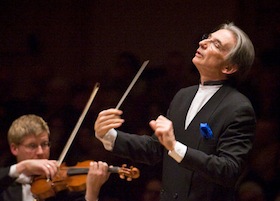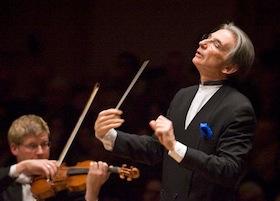
Twelve years ago, Michael Tilson Thomas organized a new music festival dedicated to some of his favorite musical iconoclasts. With programs built around composers such as John Cage, Charles Ives, Meredith Monk, and Lou Harrison, the San Francisco Symphony’s three-week “American Mavericks Festival” emerged as one of this conductor’s unmitigated triumphs.
Thursday evening at Davies Symphony Hall, Thomas and the orchestra launched the 2012 edition of Mavericks with a thrilling program featuring A Concord Symphony, Henry Brant’s transcription of Charles Ives’ “Concord” Sonata. Aaron Copland’s Orchestral Variations, and Harrison’s Concerto for Organ with Percussion Orchestra, with Paul Jacobs as soloist, completed the lineup. If the performances — brash and often breathtaking — were any indication, Bay Area music lovers are in for an exciting 10 days.
Thursday’s program may have left some wondering whether these composers can still be considered Mavericks; Copland and Ives, at least, have been firmly integrated into the standard repertoire. Yet the performances were anything but routine. And this year’s Mavericks is just getting started. Before March 19 — when the Symphony takes the festival on tour to Chicago, Ann Arbor, and New York — Bay Area audiences will hear world premieres by John Adams, Mason Bates, and Morton Subotnick, as well as works by Cage, Monk, Henry Cowell, Carl Ruggles, Harry Partch, Steve Reich, and David Del Tredici.
The program’s main event was the “Concord” Symphony. The work derives from Ives’ Sonata No. 2 for Piano. Subtitled “Concord, Mass, 1840-60,” it pays homage to the Transcendentalists, with movements named for Emerson, Hawthorne, Thoreau, and the Alcotts. Brant obtained the score in the 1950s and vowed to turn it into the “Great American Symphony.” Tilson Thomas, conducting with tremendous verve and insight, suggested his efforts were not in vain. This version, first performed in Ottawa in 1995, preserves the spirit of Ives while demonstrating Brant’s pioneering techniques in spatial music, and the S.F. Symphony, which has recorded the work, plays it with tremendous power and insight.
With its unabashed quotes (including the opening motif of Beethoven’s Fifth Symphony), boldly dissonant passages, brooding interludes, and weird collisions of hymns, marches, and parade songs, Ives’ score is a fantastic mashup. Brant’s orchestrations emphasize color, texture, and subtle shadings; softening the edges somewhat, yet expanding the work’s sound world to reach every corner of the hall.
“Emerson,” the first movement, overflowed with rich sonorities, with shimmering strings and plaintive woodwinds emerging (oboist William Bennett, flutist Tim Day and the honey-colored low strings made enraptured contributions). A manic spirit animates “Hawthorne,” a scherzo whose initial reverie gives way to careening carnival music made of hiccupping percussion, tweeting woodwinds, and blowsy horns. Thomas’ deft leadership kept the discrete strands together.
With its distant evocations of parlor songs, the third movement, “Alcotts,” seems to belong to another symphony altogether. Thomas conducted an elegant performance, eliciting warm, enveloping sound. In the finale, “Thoreau,” the score quotes Stephen Foster; the music acquires a dark, brooding edge, but tranquility is restored with a softly floated flute solo. Concluding the 50-minute performance, Thomas shaped the music in radiant statements.
At the other end of the spectrum, Copland’s Orchestral Variations opened the program in a glittering, assertive performance. Expanding on his own 1930 Piano Variations, Copland — who completed the score in 1957 on commission from the Louisville Orchestra — blazes through 20 variations in 13 minutes, engaging the orchestra section by section. Building on a four-note theme, the score achieves majestic heights in a short span; Thomas conferred a keen rhythmic edge, and well-oiled transitions, on the work.
In between, there was Harrison’s glorious and witty Organ Concerto, with the great Paul Jacobs as soloist. Nine years after the composer’s death in 2003, Harrison remains a bona fide Maverick — one of the 20th century’s most original composers, and a defining voice in the music of the West Coast. The concerto is simply a marvel. The work is scored for organ, piano, celesta, and percussion battery — drums and bells, temple blocks and glockenspiel, chimes, gongs, plumbers’ pipes, and more, with some of the instruments designed by Harrison’s partner, the late Bill Colvig — and the composer’s fascination with Indonesian gamelan is everywhere in evidence. Jacobs, often acting like a percussionist (among other techniques, he employed a padded bar to depress all the keys of an octave at once), is an outstanding soloist in any repertoire, and he outdid himself in this performance, as did the Symphony’s percussionists, pianist Robin Sutherland, and Marc Shapiro at the celesta. As Thomas summoned the music in gorgeous waves, the spirit of the original “Mavericks” filled the hall once again; as the performance concluded, the conductor kissed Harrison’s original score and held it aloft.

